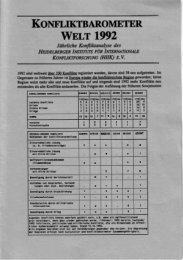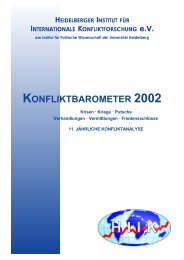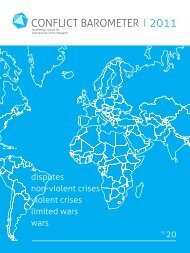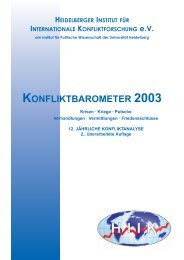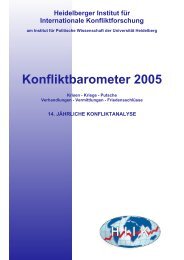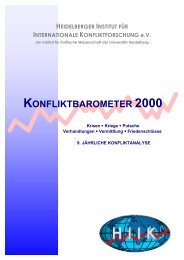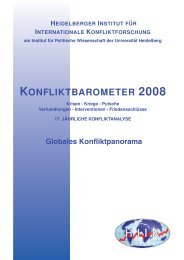CONFLICT BAROMETER 2008
CONFLICT BAROMETER 2008
CONFLICT BAROMETER 2008
Create successful ePaper yourself
Turn your PDF publications into a flip-book with our unique Google optimized e-Paper software.
48 Conflict Barometer <strong>2008</strong><br />
group’s 35th Front. A combined air and ground attack<br />
of the Colombian forces on March 1 killed Raúl Reyes,<br />
FARC’s deputy commander, together with at least 25<br />
other guerrillas on Ecuadorian territory. The incident<br />
caused a diplomatic crisis between Colombia, Ecuador,<br />
and Venezuela [→ Colombia - Ecuador; Colombia -<br />
Venezuela (system)]. Military forces succeeded in securing<br />
Reyes’s computer from the site, which contained<br />
important strategic information. On March 5, Iván Ríos,<br />
another key leader and member of the FARC secretariat,<br />
was killed by one of his subordinates for the official<br />
reward placed on Ríos’s head. FARC’s founder<br />
and highest-ranking leader, Manuel Marulanda, died of<br />
a heart attack on March 26. Guerrilla leader ”El Paisa”<br />
and another eight FARC rebels were killed on September<br />
22. Finally, ”Felipe Rincón” and a further four guerrilla<br />
members were killed in a military attack on a jungle<br />
camp in the province of Meta on October 29. Moreover,<br />
FARC suffered rising desertion and massive infiltration<br />
by state forces. For instance, on May 18, the leader of<br />
the 47th Front surrendered to the police. According to official<br />
sources, approx. 1,500 FARC rebels surrendered<br />
or deserted between January and mid-June alone. Consequently,<br />
experts estimated that FARC severely lost<br />
manpower, leaving approx. 9,000 fighters. On July<br />
2, an undercover military action succeeded in freeing<br />
long-held high-profile hostage Ingrid Betancourt and 14<br />
other hostages. Millions of people demonstrated in the<br />
capital, Bogotá, and around the world on February 4<br />
and July 20 to demand the end of FARC violence and<br />
the freeing of remaining hostages. FARC renewed its<br />
claim for a demilitarized zone and an exchange of prisoners.<br />
President Álvaro Uribe offered a certain area as<br />
demilitarized zone, which FARC rejected as being too<br />
small. The group sporadically released hostages to signalize<br />
its readiness for talks and to keep up pressure<br />
on Uribe. On January 10, FARC released two hostages<br />
after a process of mediation by Venezuelan President<br />
Hugo Chávez. Another four high-profile hostages were<br />
released on February 27. FARC conducted a series of<br />
bombings in the second half of the year. On August 15, a<br />
FARC bomb killed five people and injured 40 in Ituango<br />
in the northwestern department of Antioquia. Another<br />
ambush in the southwestern city of Cali killed a further<br />
five and injured at least 20 people. On September 17,<br />
two bombs exploded in Bogotá. Another bomb attack in<br />
the town of Neiva in the southwestern province of Huila<br />
killed one person and injured eight on October 12. Finally,<br />
FARC on October 16 offered peace talks. (jjh)<br />
Colombia (various indigenous groups)<br />
Intensity: 3 Change: Start: 2005<br />
Conflict parties: various indigenous groups vs. government<br />
Conflict items: system/ideology, resources<br />
The conflict over resources and the orientation of the<br />
political system between the Guambianos and various<br />
other indigenous groups, on the one hand, and the<br />
government, on the other, escalated to a crisis. Between<br />
October 13 and 15, approx. 22,000 indigenous<br />
protesters clashed heavily with police forces on various<br />
occasions in the southwestern departments of Cauca<br />
and Valle del Cauca. Three indigenous supporters died,<br />
and another 140 as well as ten policemen were injured.<br />
Initially, the indigenous groups had been holding protests<br />
against the loss of their native lands and the killing of<br />
more than 20 members of their tribes since the beginning<br />
of <strong>2008</strong>. They believed paramilitary groups and<br />
Colombian military forces to be responsible for these incidents.<br />
President Álvaro Uribe, however, claimed that<br />
the protesters were infiltrated by FARC rebels [→ Colombia<br />
(FARC)], and announced that no further outbreak of<br />
violence would be tolerated. After a meeting between<br />
Uribe and leaders of the indigenous groups on November<br />
2 failed to yield any results, a new protest march attended<br />
by 5,000 indigenous people was launched in the<br />
city of Cali on November 10. The march was aimed to<br />
lead to the capital, Bogotá, and inspire as many indigenous<br />
protesters as possible. (jjh)<br />
Colombia - Ecuador<br />
Intensity: 2 Change: Start: 2005<br />
Conflict parties: Colombia vs. Ecuador<br />
Conflict items: international power<br />
The conflict between Colombia and Ecuador over border<br />
violations continued. On 12/13/07, Ecuadorian President<br />
Rafael Correa announced that 11,000 army forces,<br />
a quarter of the army’s total strength, had been deployed<br />
along the border to Colombia. A combined air and<br />
ground offensive of Colombian forces targeted a FARC<br />
camp near the town of Santa Rosa, Ecuador. Operation<br />
Fénix, which involved the use of helicopters, light attack<br />
aircrafts, cluster bombs, and military squads, resulted in<br />
the death of FARC’s vice Chief Raúl Reyes and 25 suspected<br />
rebels on March 1 [→ Colombia (FARC)]. It later<br />
transpired that an Ecuadorian citizen was among those<br />
killed in the raid. In reaction, Correa heavily protested<br />
and suspended diplomatic relations with Colombia, expelling<br />
Colombia’s ambassador from the Ecuadorian<br />
capital, Quito. Furthermore, he mobilized troops in the<br />
border region. On March 3, Colombia declared its regret<br />
over the border violation but claimed that Ecuadorian authorities<br />
had ties with FARC. Correa strongly refuted the<br />
accusation. In the aftermath, both sides held talks mediated<br />
within the OAS framework and by former US President<br />
Jimmy Carter. On March 8, both presidents shook<br />
hands at the Rio Group summit in the Dominican Republic.<br />
However, an Ecuadorian military helicopter crossed<br />
the Colombian border on March 30, and was intercepted<br />
in Colombian air space by two Black Hawk helicopters.<br />
The Ecuadorian authorities apologized for the incident,<br />
claiming a navigation mistake. Despite that incident,<br />
both presidents agreed to restore low-level diplomatic relations<br />
immediately and without preconditions on June 6.<br />
(cgb, jjh)<br />
Colombia - Venezuela (system)<br />
Intensity: 2 Change: Start: 2004<br />
Conflict parties: Colombia vs. Venezuela<br />
Conflict items: system/ideology, international power<br />
The system conflict between Colombia and Venezuela<br />
continued. On January 13, Venezuelan President Hugo<br />
Chávez demanded that Colombia reclassify the leftwing



